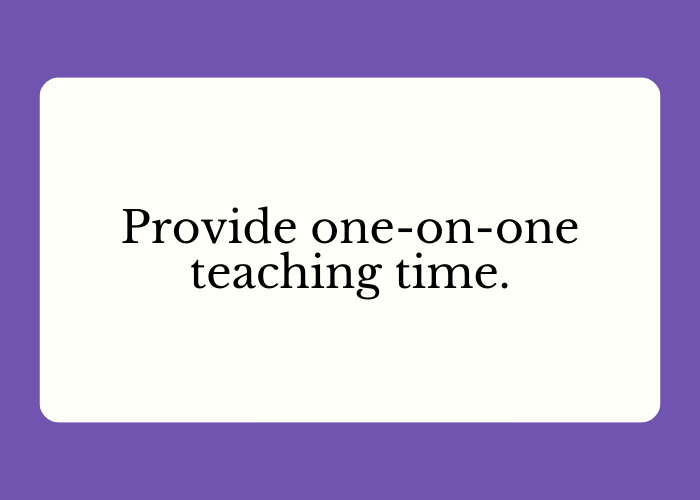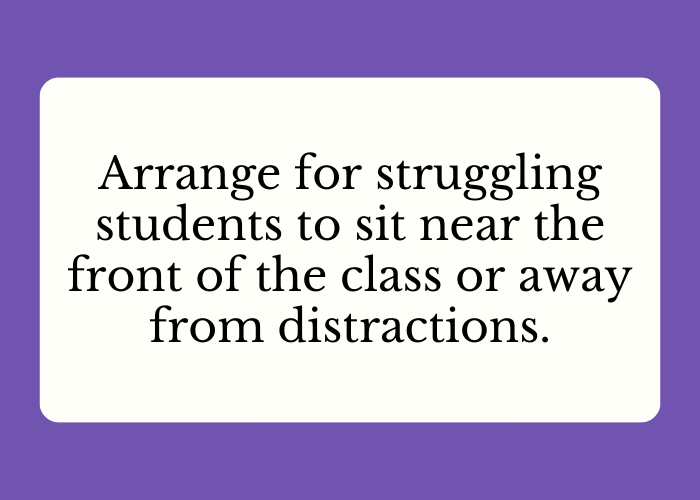Navigating the ins and outs of education can be challenging for any student, but especially for students with unique needs. This is where Individualized Education Programs (IEP) come in to help make the road that much smoother. We’ve devised a comprehensive guide of 82 impactful IEP accommodations that you can use to enhance the learning experience for these learners. Our accommodations aim to help you facilitate personalized, effective, and engaging lessons. So, if you’re keen on turning potential obstacles into stepping stones for success, take a look at the tips below!
Instructional Methods and Presentation Accommodations
1. Use visual aids to complement verbal instruction.

2. Provide one-on-one teaching time.

3. Simplify complex instructions into smaller steps and repeat them as many times as necessary.

4. Use tools to help organize thoughts and information.

5. Utilize a mix of auditory, visual, and tactile teaching methods.

6. Use role-playing to teach and reinforce concepts.

7. Use cues and mnemonics to aid memory.

8. Display the daily and weekly schedules with visuals.

9. Provide step-by-step instructions for tasks.

10. Provide instruction in touch typing for students with fine motor skill issues.

11. Use a pointer to guide reading or following along.

12. Demonstrate new skills visually before expecting the student to perform them.

13. Provide scaffolding of new material, gradually reducing support as the student becomes more proficient.

14. Use graphic organizers to visually represent information, aiding comprehension.

15. Use physical items or tools that help students understand abstract concepts.

16. Apply concepts being taught to real-life situations to increase comprehension.

17. Use software that can adapt to a student’s level of understanding and pace of learning.

18. Tailor teaching methods and pace to the individual student’s needs.

19. Highlight key information in textbooks to aid understanding and retention.

20. Regularly review previously taught material to ensure understanding and retention.

Environmental Adjustments Accommodations
21. Arrange for struggling students to sit near the front of the class or away from distractions.

22. Allow brief physical activity breaks.

23. Minimize noise and visual distractions during tests.

24. Offer choices for seating that suit the student’s needs.

25. Establish clear routines and consistently follow them.

26. Provide a quiet space for calming down or concentrated work.

27. Use physical barriers to minimize distractions.

28. Provide noise-canceling devices for students who are easily distracted by noise.

29. Ensure the classroom temperature is comfortable for all students.

30. Use natural lighting where possible to create a comfortable learning environment.

31. Use non-glare work surfaces to reduce visual strain.

32. Ensure restrooms are accessible and meet the student’s needs.

Assignment and Test Modifications Accommodations
33. Allow additional time for assignments and tests.

34. Reduce the volume of homework or assignments while maintaining the core learning objectives.

35. Allow for verbal responses in testing.

36. Modify assignments to cater to a student’s strengths.

37. Allow retakes, provide tests in different formats, and offer one-on-one or small-group testing environments.

38. Break down complex information into smaller, manageable parts.

39. Assign smaller, manageable tasks.

40. Allow short breaks between tasks.

41. Adapt physical education activities as needed.

42. Offer oral exams as an alternative to written exams.

43. Allow for comfort items like cushions or footrests to be used in the session.

Organizational Aids Accommodations
44. Provide tools such as daily planners and calendars.

45. Provide a checklist for assignments to guide the student.

46. Help the student to prioritize their tasks to adopt a more efficient workload.

47. Establish clear rules and consistently enforce them.

48. Use a timer to help the student manage their time effectively.

49. Help the student keep their materials and workspace organized.

50. Establish a daily check-in to review assignments and plan for the day.

51. Use color-coded folders for different subjects to help students stay organized.

52. Provide a clear daily agenda so students know what to expect.

Assistive Tools and Support Accommodations
53. Implement technology like speech-to-text software, specialized software, and audiobooks.

54. Provide a peer or adult to help take notes, offer supplementary teacher notes, or help with note-taking strategies.

55. Provide a sign language interpreter if needed, and use captioned videos and closed captions for students with hearing impairments.

56. Provide textbooks and materials for preview before lessons.

57. Permit the use of calculators where appropriate.

58. Do not deduct points for spelling errors on non-spelling assignments.

59. Permit the use of computers for typing assignments, headphones for audio recordings, or amplification devices for hearing impairments.

60. Allow the use of highlighters to mark key points in texts.

61. Allow the student to dictate responses to a scribe.

62. Use physical objects to teach math concepts.

63. Use written communication for important information.

64. Pair the student with a peer tutor.

65. Provide written as well as verbal homework instructions.

66. Offer support in taking effective notes during lessons.

67. Allow the student to stand or move while working if it helps their concentration.

68. Provide a reader for students with visual impairments or reading difficulties.

69. Provide movement aids (like a fidget toy) if they help the student concentrate.

70. Incorporate exercises or activities to improve fine and gross motor skills.

71. Allow the use of a typewriter for students who have difficulty with handwriting.

72. Do not penalize for poor handwriting.

73. Use examples that are relevant to the student’s experiences.

74. Provide materials in Braille for students with visual impairments.

75. Offer emotional support and encourage self-confidence.

76. Provide explicit instruction in social skills.

77. Provide adapted equipment for physical tasks or activities.

78. Adjust attendance requirements due to medical needs.

79. Assist with personal care if needed.

80. Make necessary adjustments for sensory processing issues.

81. Stay near the student during work time to support focus and provide assistance.

82. Keep close track of the student’s progress and adjust instruction as needed.
